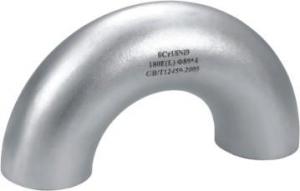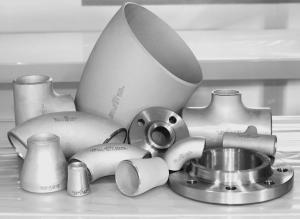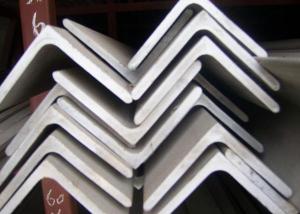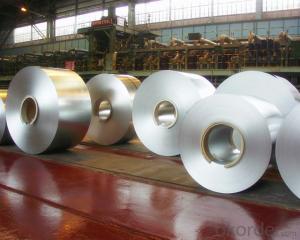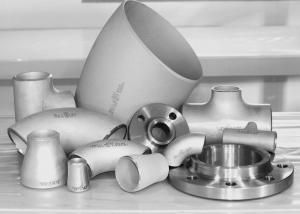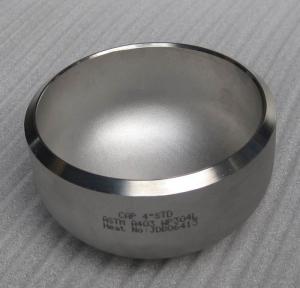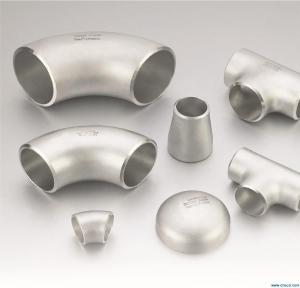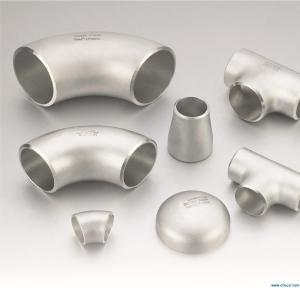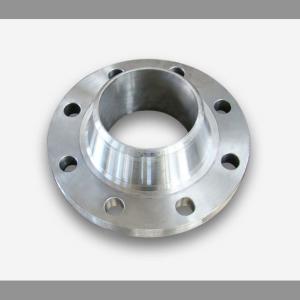Stainless Steel Cross
- Loading Port:
- China Main Port
- Payment Terms:
- TT or LC
- Min Order Qty:
- 5 Pieces pc
- Supply Capability:
- 10000 Pieces Per Month pc/month
OKorder Service Pledge
OKorder Financial Service
You Might Also Like
Stainless Steel Fittings
Specifications Features:
1) Carbon steel fitting and stainless steel fitting
2) Standard: ASME, ANSI, API, JIS
1. BUTT WELDED FITTING:
2. Production acc. to the standard of GB /ASTM / ASME / DIN / JIS
ASTM B 16.9 /16.11 B 16.28 JIS B 2311/2220 DIN2617/2616/2615/2391
3. Types: Elbows, seamless and welded, LR & SR ,Bend -Equal and reducing Tees,
seamless and welded - Concentric and eccentric Reducers,seamless and welded -Caps
4. Wall thickness: From Sch5 up to Sch160/STD/XS/XXS
5. Material Grades: A403,WP304, WP304L, Wp316, WP316L, A234WPB
6. Dimensions: Seamless: from 1/2' up to 24'
7. size: From 1/2" up to 72"
Outer packing:Seaworthy plywood case
|
Grade |
TP304,TP304L,TP321,TP316L,TP310S etc. |
|
connection |
welding |
|
techniques |
forged |
|
Surface finishing |
180/240/320/400 grit |

- Q:Can stainless steel flats be used in the petrochemical industry?
- Yes, stainless steel flats can be used in the petrochemical industry. Stainless steel offers excellent corrosion resistance and high temperature resistance, making it suitable for various applications in the petrochemical industry, such as storage tanks, pipelines, and equipment components. Additionally, stainless steel's durability and strength make it ideal for withstanding the harsh conditions and corrosive substances found in petrochemical processes.
- Q:What are the different types of stainless steel flats used in the electronics industry?
- There are several different types of stainless steel flats commonly used in the electronics industry, including austenitic stainless steel, ferritic stainless steel, and martensitic stainless steel. Each type offers unique properties such as corrosion resistance, strength, and magnetic characteristics, allowing for various applications in electronic devices and components.
- Q:What is the maximum width of stainless steel flats available?
- The maximum width of stainless steel flats available can vary depending on the supplier and the specific grade of stainless steel being used. However, in general, stainless steel flats are commonly available in widths ranging from 12 inches to 48 inches. Some suppliers may be able to provide wider options upon request, but it is recommended to consult with the supplier or manufacturer to determine the exact maximum width available for a specific stainless steel flat.
- Q:What are the different surface patterns available for stainless steel flats?
- Stainless steel flats come in a variety of surface patterns. One popular option is a smooth or polished finish, which provides a glossy and reflective appearance. This type of finish is commonly used in decorative fields like architecture and interior design, where aesthetics are crucial. Another well-liked surface pattern is a brushed finish, achieved by rubbing the stainless steel with a fine abrasive material. This creates a consistent, directional grain on the surface, resulting in a textured appearance. Brushed finishes are often utilized in kitchen appliances such as sinks and countertops, as they effectively conceal scratches and fingerprints. In addition, there are textured or embossed finishes available for stainless steel flats. These patterns are achieved by imprinting the surface with designs or textures like diamonds or leather grain. Textured finishes add visual interest and can also provide improved grip, making them suitable for applications like elevator doors or high-traffic flooring. Other surface patterns for stainless steel flats include bead blasted, which creates a matte finish with a slightly rough texture, and patterned finishes like checker or diamond plate, featuring raised or recessed patterns for enhanced traction. These patterns are commonly found in industrial or commercial settings like transportation or manufacturing. Ultimately, the choice of surface pattern for stainless steel flats depends on the intended application and desired aesthetic. Each pattern offers a distinct appearance and functional benefits, allowing for versatility in various industries and design preferences.
- Q:Are stainless steel flats suitable for the manufacturing of storage tanks?
- Yes, stainless steel flats are suitable for the manufacturing of storage tanks. Stainless steel is known for its corrosion resistance, durability, and high strength-to-weight ratio, making it an excellent choice for storing various liquids and gases. Additionally, stainless steel is easy to clean, maintain, and has a long lifespan, making it a reliable material for storage tank fabrication.
- Q:Can stainless steel flats be used in the food processing industry?
- Yes, stainless steel flats can be used in the food processing industry. Stainless steel is a highly durable and corrosion-resistant material that is suitable for use in environments where hygiene and cleanliness are of utmost importance. Stainless steel flats are commonly used in the food processing industry for various applications, such as conveyor belts, work surfaces, storage containers, and equipment components. Stainless steel has several properties that make it ideal for food processing. Firstly, it is non-porous, which means that it does not absorb or retain food particles, bacteria, or odors. This makes it easy to clean and maintain a sanitary environment. Additionally, stainless steel is resistant to corrosion, rust, and staining, which ensures that the flats remain in good condition even when exposed to water, cleaning chemicals, and food acids. Furthermore, stainless steel is inert and does not react with food or food processing ingredients, thereby preventing any contamination or alteration of the food's taste or quality. It is also a heat-resistant material, which allows stainless steel flats to withstand high-temperature processes such as sterilization or cooking without warping or deforming. Overall, stainless steel flats are a reliable and hygienic choice for the food processing industry. They provide a durable, low-maintenance, and safe surface for food preparation, handling, and storage.
- Q:Do stainless steel flats require regular maintenance?
- Yes, stainless steel flats do require regular maintenance to maintain their appearance and prevent corrosion. This typically involves regular cleaning with mild soap and water, avoiding harsh chemicals or abrasive materials. Additionally, periodic inspection and polishing may be necessary to remove any scratches or marks on the surface.
- Q:How do stainless steel flats perform in cryogenic environments?
- Stainless steel flats are known for their excellent performance in various environments, including cryogenic conditions. Cryogenic environments refer to extremely low temperatures below -150 degrees Celsius (-238 degrees Fahrenheit). Stainless steel flats are highly resistant to corrosion, and this quality extends to cryogenic environments as well. The chromium content in stainless steel forms a protective oxide layer on the surface, preventing the metal from reacting with the surrounding environment. This oxide layer remains intact even in cryogenic temperatures, providing long-term protection against corrosion. Stainless steel also exhibits exceptional mechanical properties in cryogenic conditions. It maintains its strength and toughness, allowing it to withstand low temperatures without becoming brittle or prone to fractures. This is crucial in applications where structural integrity is essential, such as in cryogenic storage tanks, pipelines, and aerospace components. Furthermore, stainless steel flats offer good thermal conductivity, which is important in cryogenic environments. It helps to efficiently transfer heat, preventing the formation of cold spots and ensuring consistent temperature distribution. This property is particularly beneficial in cryogenic applications where precise temperature control is crucial, such as in medical and scientific research facilities. In conclusion, stainless steel flats perform exceptionally well in cryogenic environments. Their resistance to corrosion, maintained mechanical properties, and efficient thermal conductivity make them reliable and durable materials for various cryogenic applications.
- Q:Can stainless steel flats be passivated?
- Yes, stainless steel flats can be passivated. Passivation is the process of treating stainless steel with a mild oxidizing agent, such as nitric acid or citric acid, to remove any surface contaminants and enhance its corrosion resistance. Passivation creates a protective oxide layer on the surface of the stainless steel, which helps to prevent rust and other forms of corrosion. This process is commonly used in various industries, including the manufacturing of stainless steel flats, to ensure the longevity and durability of the material.
- Q:How do stainless steel flats resist hydrogen sulfide corrosion?
- Stainless steel flats are able to resist hydrogen sulfide corrosion due to their unique composition and properties. Stainless steel is made up of iron, chromium, and other alloying elements, which create a protective layer on the surface of the metal. This layer, known as the passive layer, acts as a barrier between the stainless steel and the surrounding environment. When stainless steel flats come into contact with hydrogen sulfide, the passive layer forms a thin, dense chromium oxide film on the surface. This film is highly resistant to corrosion and prevents the hydrogen sulfide from penetrating the metal. Additionally, the alloying elements in stainless steel, such as molybdenum and nickel, enhance its resistance to hydrogen sulfide corrosion. Furthermore, stainless steel flats have excellent mechanical properties, such as high strength and toughness, which make them more resistant to damage caused by hydrogen sulfide corrosion. This allows the stainless steel to maintain its integrity and structural stability even in harsh environments. In summary, stainless steel flats resist hydrogen sulfide corrosion due to the formation of a protective passive layer on the surface, the presence of alloying elements, and their robust mechanical properties. These characteristics make stainless steel an ideal material for applications where exposure to hydrogen sulfide is a concern.
1. Manufacturer Overview |
|
|---|---|
| Location | Zhejiang, China |
| Year Established | 2010 |
| Annual Output Value | above US$16 million |
| Main Markets | East Asia, Middle East. |
| Company Certifications | |
2. Manufacturer Certificates |
|
|---|---|
| a) Certification Name | |
| Range | |
| Reference | |
| Validity Period | |
3. Manufacturer Capability |
|
|---|---|
| a)Trade Capacity | |
| Nearest Port | Shanghai |
| Export Percentage | |
| No.of Employees in Trade Department | above 10 people |
| Language Spoken: | English, Chinese |
| b)Factory Information | |
| Factory Size: | about 30000 square meter |
| No. of Production Lines | above 7 |
| Contract Manufacturing | OEM Service Offered |
| Product Price Range | Average |
Send your message to us
Stainless Steel Cross
- Loading Port:
- China Main Port
- Payment Terms:
- TT or LC
- Min Order Qty:
- 5 Pieces pc
- Supply Capability:
- 10000 Pieces Per Month pc/month
OKorder Service Pledge
OKorder Financial Service
Similar products
New products
Hot products
Related keywords
